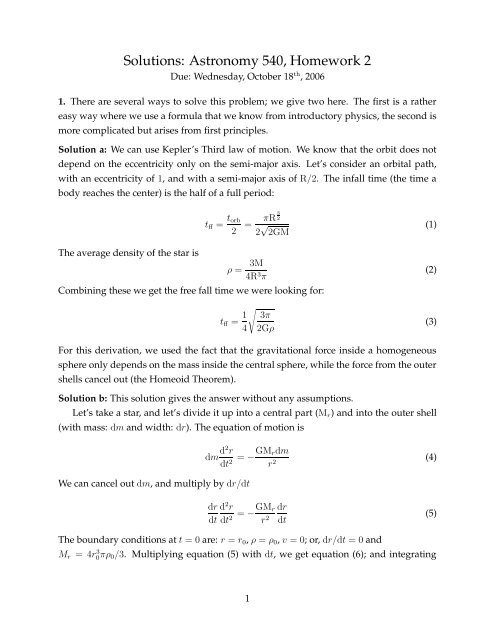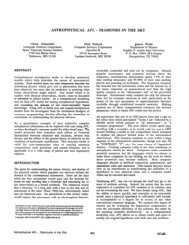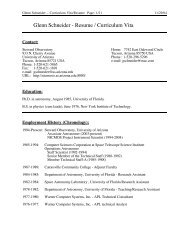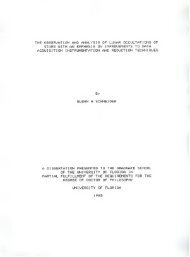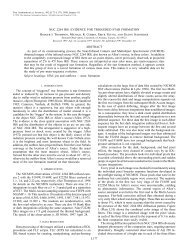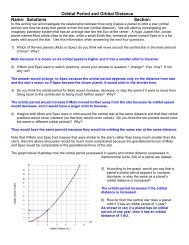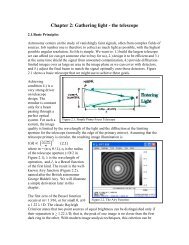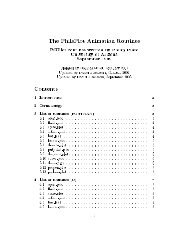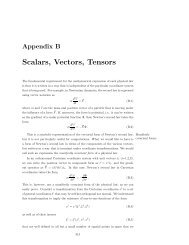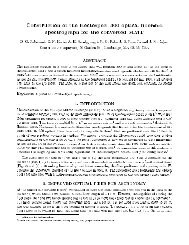Solutions for Homework #2
Solutions for Homework #2
Solutions for Homework #2
You also want an ePaper? Increase the reach of your titles
YUMPU automatically turns print PDFs into web optimized ePapers that Google loves.
<strong>Solutions</strong>: Astronomy 540, <strong>Homework</strong> 2<br />
Due: Wednesday, October 18 th , 2006<br />
1. There are several ways to solve this problem; we give two here. The first is a rather<br />
easy way where we use a <strong>for</strong>mula that we know from introductory physics, the second is<br />
more complicated but arises from first principles.<br />
Solution a: We can use Kepler’s Third law of motion. We know that the orbit does not<br />
depend on the eccentricity only on the semi-major axis. Let’s consider an orbital path,<br />
with an eccentricity of 1, and with a semi-major axis of R/2. The infall time (the time a<br />
body reaches the center) is the half of a full period:<br />
The average density of the star is<br />
t ff = t orb<br />
2 = πR 3 2<br />
2 √ 2GM<br />
ρ =<br />
3M<br />
4R 3 π<br />
Combining these we get the free fall time we were looking <strong>for</strong>:<br />
t ff = 1 4<br />
√<br />
3π<br />
2Gρ<br />
(1)<br />
(2)<br />
(3)<br />
For this derivation, we used the fact that the gravitational <strong>for</strong>ce inside a homogeneous<br />
sphere only depends on the mass inside the central sphere, while the <strong>for</strong>ce from the outer<br />
shells cancel out (the Homeoid Theorem).<br />
Solution b: This solution gives the answer without any assumptions.<br />
Let’s take a star, and let’s divide it up into a central part (M r ) and into the outer shell<br />
(with mass: dm and width: dr). The equation of motion is<br />
We can cancel out dm, and multiply by dr/dt<br />
dm d2 r<br />
dt 2 = −GM rdm<br />
r 2 (4)<br />
dr d 2 r<br />
dt dt = −GM r dr<br />
2 r 2 dt<br />
(5)<br />
The boundary conditions at t = 0 are: r = r 0 , ρ = ρ 0 , v = 0; or, dr/dt = 0 and<br />
M r<br />
= 4r 3 0 πρ 0/3. Multiplying equation (5) with dt, we get equation (6); and integrating<br />
1
that, we get equation (7):<br />
dr d 2 r<br />
dt = −4πG<br />
dt dt2 3r 2 r3 0 ρ 0dr (6)<br />
( ) 2<br />
1 dr<br />
= 4πG<br />
2 dt 3r r3 0ρ 0 + C 1 (7)<br />
At r = r 0 (t = 0) we know that dr/dt = 0, so the constant of integration is<br />
C 1 = − 4πG<br />
3 r2 0 ρ 0 (8)<br />
so this gives:<br />
√<br />
( )<br />
dr 8πG<br />
dt = 3 ρ 0r0<br />
2 r0<br />
r − 1<br />
(9)<br />
Let us use new parameters to make the derivation more simple. Let K be:<br />
K =<br />
√<br />
8πG<br />
3 ρ 0 (10)<br />
and let θ be<br />
θ = r r 0<br />
(11)<br />
This way<br />
so dθr 0 = dr. The equation of motion then becomes:<br />
Now let θ = cos 2 ξ. This way<br />
dθ<br />
dr = 1 r 0<br />
(12)<br />
dθ<br />
dt = K √<br />
1<br />
θ − 1 (13)<br />
dθ<br />
dξ<br />
The equation of motion then becomes:<br />
= 2 sin ξ cos ξ (14)<br />
2 sin ξ cos ξ dξ<br />
dt<br />
cos 2 ξ dξ<br />
dt<br />
√<br />
1<br />
= K<br />
cos 2 ξ − 1 (15)<br />
= K sin ξ<br />
(16)<br />
cos ξ<br />
= K 2<br />
(17)<br />
2
After separating the variables and integrating, this comes to be<br />
1<br />
2 ξ − 1 4 sin(2ξ) = K 2 t + C 2 (18)<br />
Looking at the boundary conditions (t = 0, r = r 0 ) we know that θ = 1 and cos 2 ξ = 1,<br />
which means that ξ = 0. So that gives us C 2 = 0. At t = t ff , we know that r = 0, which<br />
means that θ = 0, so ξ = π/2. So at the end of the infall<br />
π<br />
4 − 1 4 sin(π) = K 2 t ff (19)<br />
so the free-fall time is:<br />
If we substitute the value of K, we get:<br />
t ff =<br />
π<br />
2K<br />
(20)<br />
t ff = 1 4<br />
√<br />
3π<br />
2Gρ<br />
(21)<br />
For the Sun, this value is about 27 minutes.<br />
2.a The distribution function gives the density distribution in a unit volume over velocities.<br />
If we integrate the distribution function over velocities, we get the density at a certain<br />
z position.<br />
ρ(z) =<br />
Substituting the distribution function, we get<br />
∫ ∞<br />
−∞<br />
ρ(z) = ρ 0<br />
√<br />
2πσ<br />
2<br />
z<br />
∫ ∞<br />
−∞<br />
fdv z (22)<br />
e − Φ(z)+v2 z /2<br />
σ 2 z dv z (23)<br />
This can be rewritten as<br />
ρ(z) = ρ 0<br />
√<br />
2πσ<br />
2 z<br />
∫ ∞<br />
−∞<br />
e − Φ(z)<br />
σz<br />
2 e − v2 z<br />
2σz 2 dv z (24)<br />
The first exponential part of the integral is a constant, so it can be brought out in front of<br />
the integral. The second part is the well known Gaussian distribution with the 1/ √ 2πσ 2 z,<br />
which integrated over −∞ to ∞ equals one. So we get<br />
ρ(z) = ρ 0 e − Φ(z)<br />
σ 2 z (25)<br />
3
For an axisymmetric thin disk, the Poisson equation’s dependence from R cancels, and<br />
we get<br />
d 2 Φ(z)<br />
dz 2<br />
= 4πGρ(z) = 4πGρ 0 e − Φ(z)<br />
σ 2 z (26)<br />
Let’s convert this with the dimensionless units given in the problem. We know, that z =<br />
ζz 0 . That gives<br />
σ z<br />
z = ζ √ (27)<br />
8πGρ0<br />
Let’s substitute this and the φ = Φ/σ 2 z<br />
into the Poisson equation<br />
d 2 (φσz 2)<br />
d ( ) = 4πGρ<br />
ζ 2 σz<br />
2 0 e −φ (28)<br />
8πGρ 0<br />
The constants can be brought out of the derivative, and then we get the <strong>for</strong>m we were<br />
looking <strong>for</strong>:<br />
2 ∂2 φ<br />
∂ζ 2 = e−φ (29)<br />
2.b It can be noticed, that this is a harmonic oscillator type of equation, so let’s multiply<br />
both sides with the derivative of the value. We get<br />
2 dφ d 2 φ<br />
dζ dζ = dφ<br />
2 dζ e−φ (30)<br />
This is the same type of integral as was equation (6) in the first problem. Let’s integrate<br />
the equation.<br />
( ) 2<br />
dφ<br />
= −e −φ + c (31)<br />
dζ<br />
The integrational constant can be calculated if we know that the potential at the center of<br />
the galactic plane is zero. That means that the gradient is also zero when ζ is zero. So we<br />
get c = 1. We can take the square root of the equation and rearrange it.<br />
dφ =<br />
√<br />
1 − e −φ dζ (32)<br />
We will have to integrate this equation. Since the square root part is not to convenient,<br />
let’s change variables, and arrange the equation so we have the same variables at the<br />
same side. Let x = √ 1 − e −φ . That means that<br />
dx =<br />
e −φ<br />
2 √ dφ (33)<br />
1 − e−φ 4
dx = 1 − x2<br />
dφ (34)<br />
2x<br />
2x<br />
dφ = dx (35)<br />
1 − x2 That changes our equation to be<br />
By integrating that, we get<br />
dζ = 2 dx (36)<br />
1 − x2 ζ + const = 2 tanh −1 x (37)<br />
Arranging that, and substituting x we get<br />
tanh −1 (√<br />
1 − e −φ )<br />
= ζ + const<br />
2<br />
(38)<br />
Taking the hyperbolic tangent of the equation we get<br />
√<br />
1 − e −φ = tanh<br />
( ) ζ + const<br />
2<br />
(39)<br />
>From the boundary conditions, we can see that the constant of integration is zero again.<br />
So we get<br />
( ) ζ<br />
e −φ = 1 − tanh 2 (40)<br />
2<br />
Using tanh 2 + sech 2 = 1, we get<br />
e −φ = sech 2 ( ζ<br />
2<br />
)<br />
(41)<br />
In the a part of the problem, we saw that e −φ = ρ(z)/ρ 0 . Substituting <strong>for</strong> that as well as<br />
<strong>for</strong> ζ we get the equation given by Spitzer:<br />
ρ(z) = ρ 0 sech 2 ( z<br />
2z 0<br />
)<br />
(42)<br />
3.a. The problem as given in Binney & Tremaine is a bit misleading, since if we use the<br />
original Maxwellian distribution function given, we cannot derive the equation that we<br />
are looking <strong>for</strong>. The original function given is<br />
f 0 (v) =<br />
ν 0<br />
v2<br />
(2πσ 2 e− 2σ<br />
3/2 2 (43)<br />
)<br />
We know that this is a Gaussian distribution, with the particles’ energy in the exponential<br />
5
part. Since our system also has a central mass (the black hole), the original Maxwellian<br />
distribution function has to be modified, so that<br />
E i = 1 2 v2 + V (44)<br />
where<br />
Our distribution function then is<br />
V = − GM r<br />
(45)<br />
f 0 (v) =<br />
ν 0<br />
GM<br />
e<br />
(2πσ 2 3/2<br />
)<br />
rσ 2 − v2<br />
2σ 2 (46)<br />
The velocity distribution can be derived from<br />
∫ vmax<br />
ν(r) = 4π v 2 f 0 (v)dv (47)<br />
v min<br />
To calculate that, we have to know the boundary velocities. Since we are looking at "unbound"<br />
particles, we know that the smallest allowable velocity is their "free" velocity,<br />
√<br />
which is v min = 2GM/r. The outer velocity boundary has to be ∞. Our starting equation<br />
then becomes<br />
By substituting our Maxwellian distribution, we get<br />
∫ ∞√<br />
ν(r) = 4π v 2 f 0 (v)dv (48)<br />
2GM/r<br />
∫<br />
ν(r)<br />
∞√<br />
= 4π v 2 1 GM<br />
e rσ<br />
ν 0 2GM/r (2πσ 2 3/2 2 − v2<br />
2σ 2 dv (49)<br />
)<br />
This equation is not straight<strong>for</strong>wardly solvable, but can be done using Mathematica,<br />
which immediately gives the desired solution:<br />
√ [ (√<br />
ν(r) rH<br />
= 2<br />
ν 0 πr + rH er H/r<br />
1 − erf<br />
r<br />
)]<br />
(50)<br />
3.b. To obtain the behavior at r ≪ r H , we use equation (1C-13) from Binney & Tremaine<br />
which says:<br />
e−x2<br />
lim (1 − erf x) = √ . (51)<br />
x→∞ πx<br />
6
We can use this to approximate the second term <strong>for</strong> r → 0, which yields<br />
√<br />
ν(r) rH<br />
≈ 2<br />
ν 0 πr + e er H/r<br />
−r H/r<br />
√ π<br />
√r H /r . (52)<br />
>From this it is straight<strong>for</strong>ward to see that the second term goes to zero as r → 0. This<br />
can also be seen by plotting the function, as shown in Figure 1.<br />
1<br />
exp(1/x)*(1-erf(sqrt(1/x)))<br />
0.9<br />
0.8<br />
0.7<br />
0.6<br />
0.5<br />
0.4<br />
0.3<br />
0.2<br />
0.1<br />
0<br />
-10 -5 0 5 10<br />
Figure 1: The second part of the density function<br />
Hence the density profile at r ≪ r H is<br />
√<br />
ν(r) rH<br />
= 2<br />
ν 0 πr<br />
(53)<br />
or<br />
ν(r) ∝ r −1/2 (54)<br />
4. To solve this problem, we have to make a few assumptions. The first, and most important<br />
one, is that the Cluster Formation Rate (CFR) was constant throughout the lifetime<br />
of the Galaxy. The data plot can be seen in Figure 2.<br />
An equation can be fitted to the points<br />
N = N 0 10 −ta , (55)<br />
where N 0 is an initial number density, t is the elapsed time, and a is a constant. The data<br />
points are fit with N 0 = 78 and a = 0.5.<br />
To estimate the number of stars from dispersed clusters, we need to compute the<br />
difference between the number of clusters observed in a time interval as compared to<br />
7
100<br />
10<br />
N clust [1/(kpc 2 Gyr)]<br />
1<br />
0.1<br />
0.001 0.01 0.1 1 10<br />
age [Gyr]<br />
Figure 2: The fitted curve to the number density of clusters<br />
the number of clusters that <strong>for</strong>med (ie., compute the area between a horizonatal line at<br />
78clusters/kpc 2 /Gyr and the fit to the data points). This yields<br />
N disp = 766 clusters<br />
kpc 2<br />
∗<br />
x1000<br />
cluster<br />
(56)<br />
Converted to the number of stars per square parsec,<br />
If we distribute this into a 100pc thick layer, we get<br />
The stellar number density in the Solar neighborhood is<br />
ρ stars = .7665 ∗<br />
pc 2 (57)<br />
ρ stars = 0.007662 ∗<br />
pc 3 (58)<br />
ρ stars ∼ 0.14 ∗<br />
pc 3 (59)<br />
Which means that about 5% of the stars in the solar neighborhood have been <strong>for</strong>med in<br />
clusters. This number is an underestimate primarily because of our assumption that the<br />
star <strong>for</strong>mation rate in the past was the same as it is now (likely was higher).<br />
8


